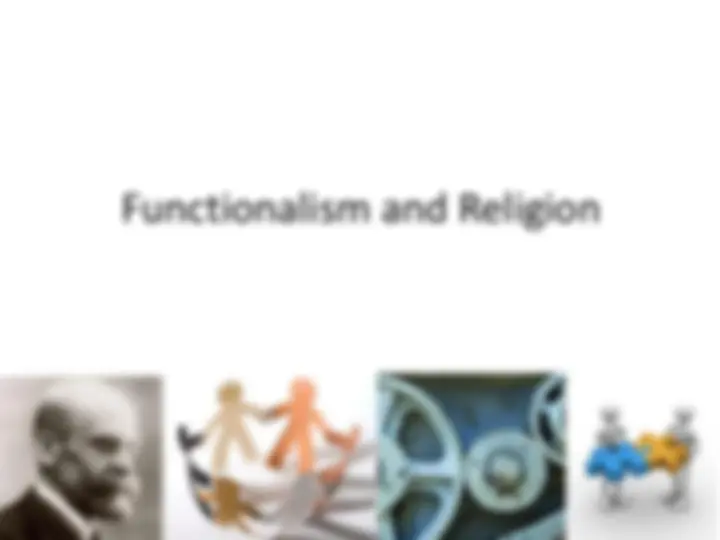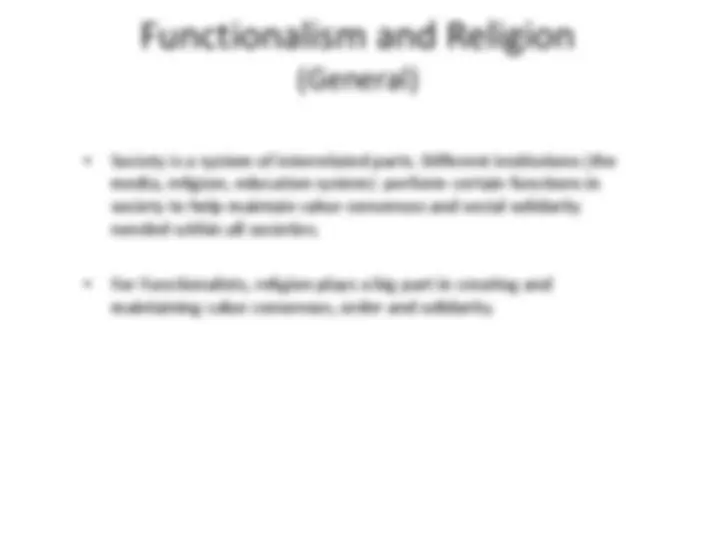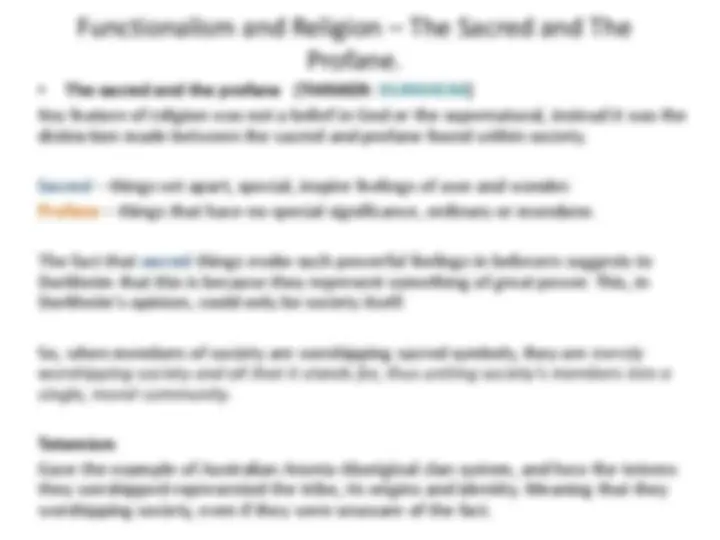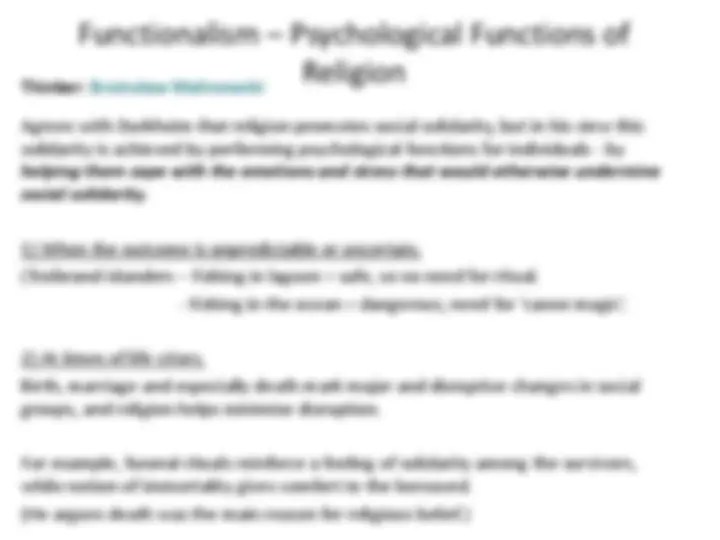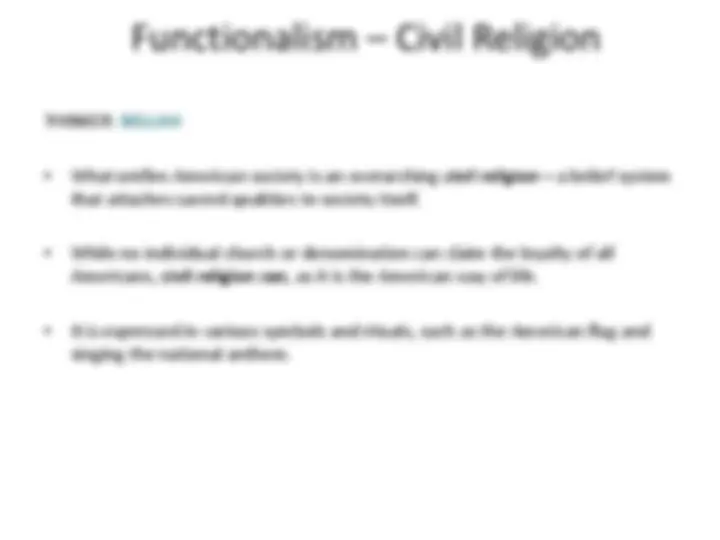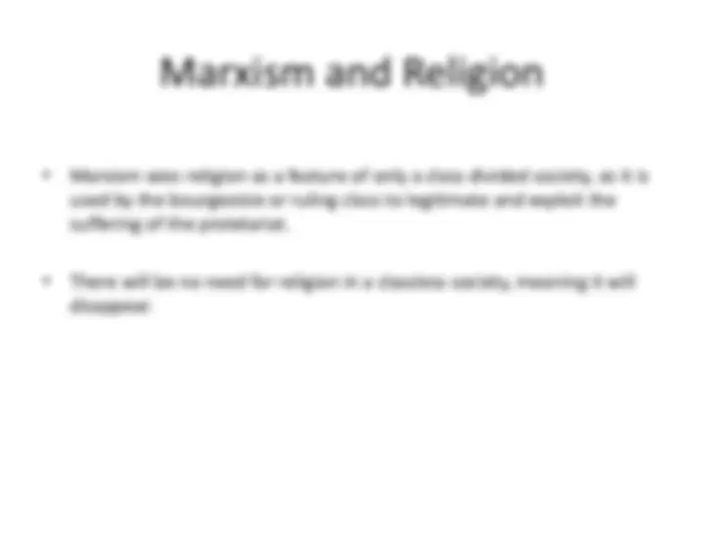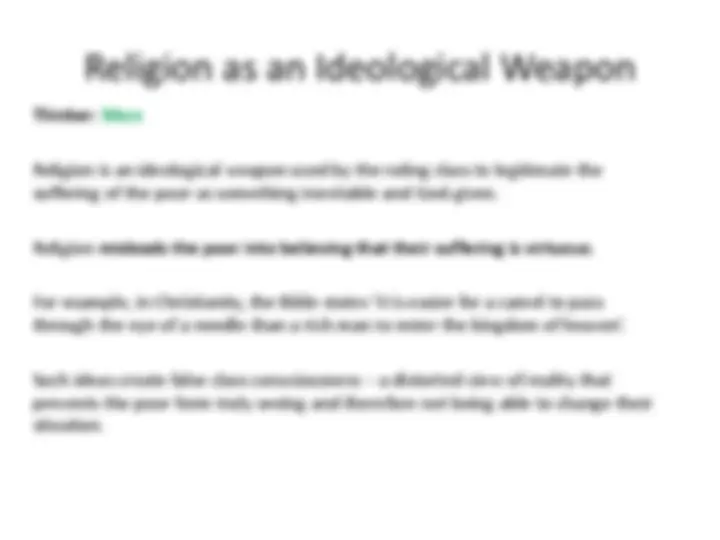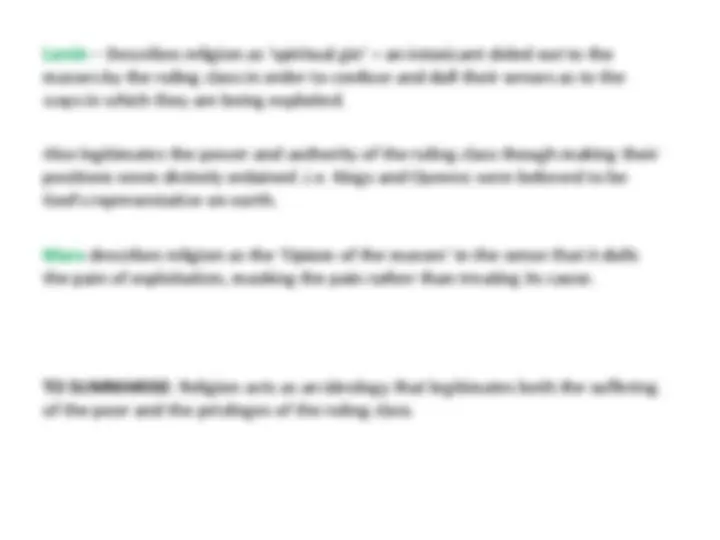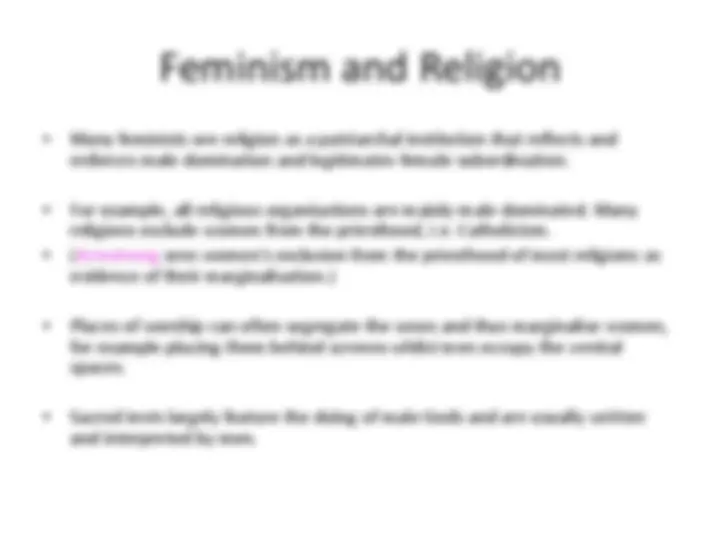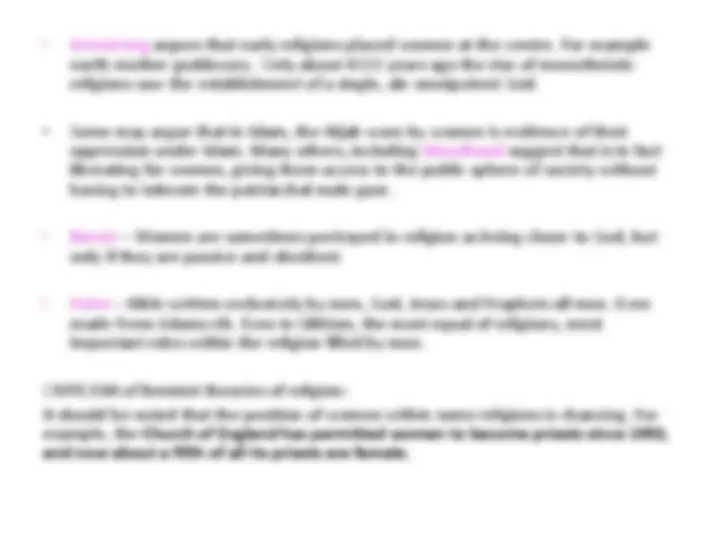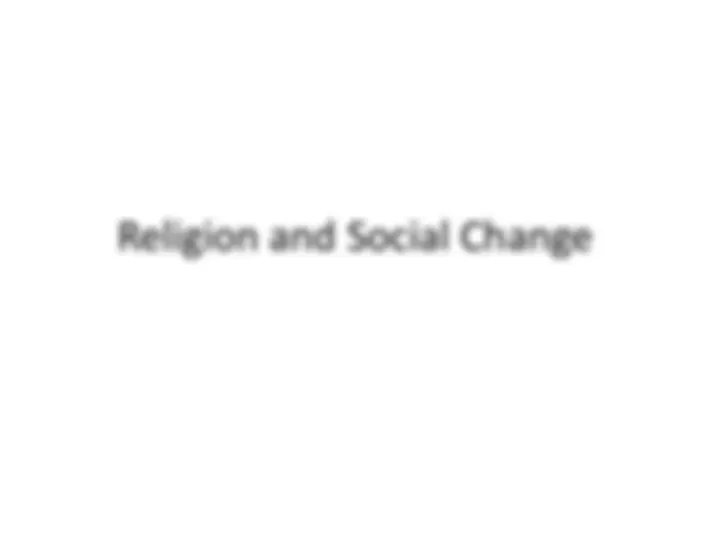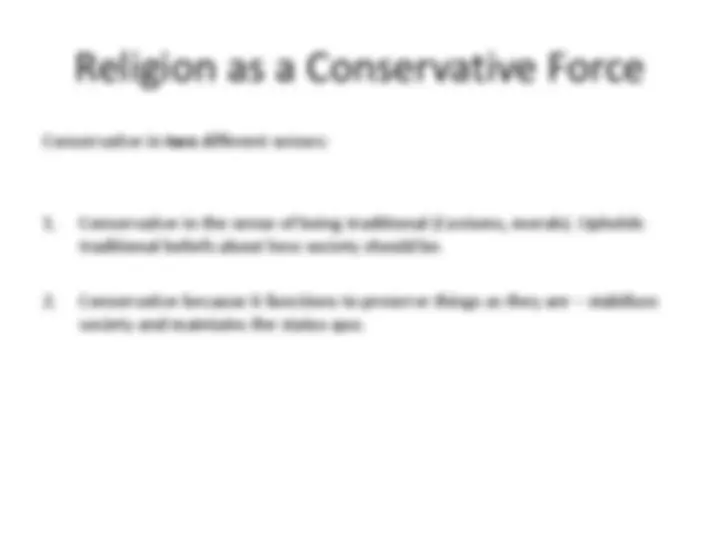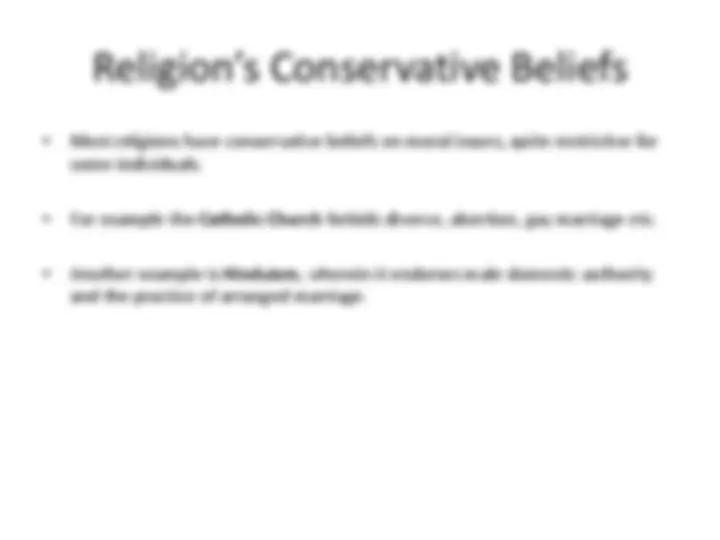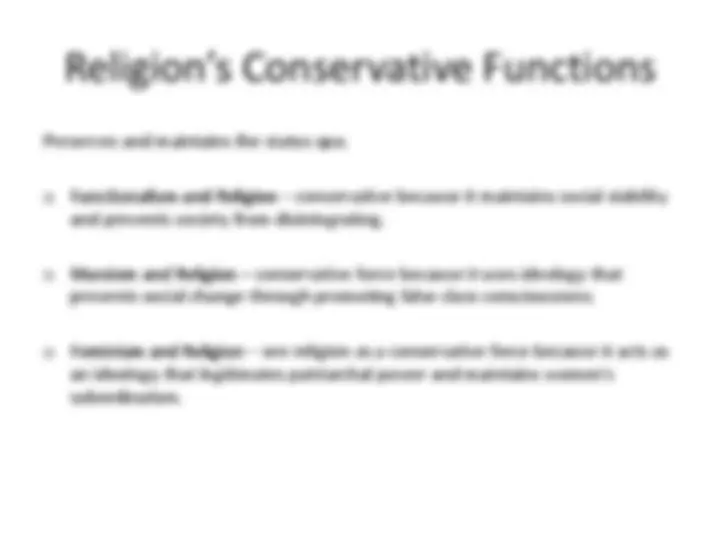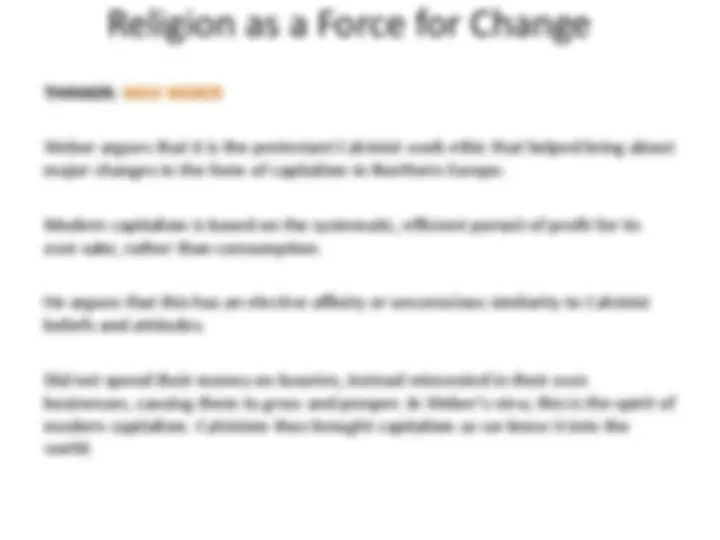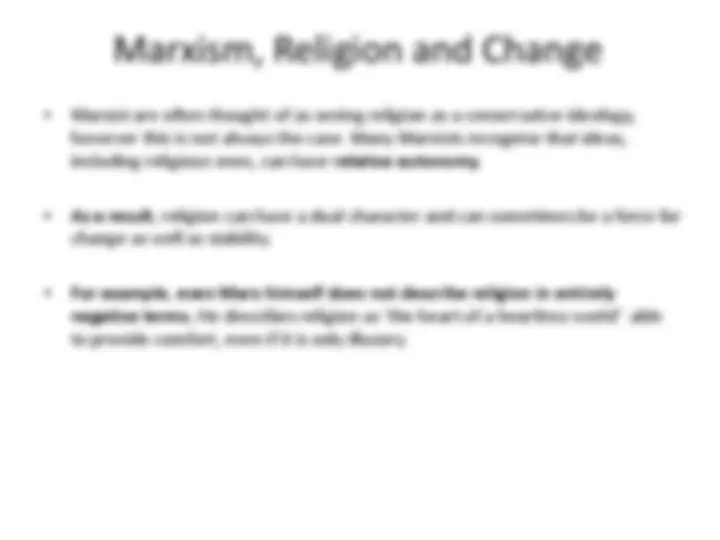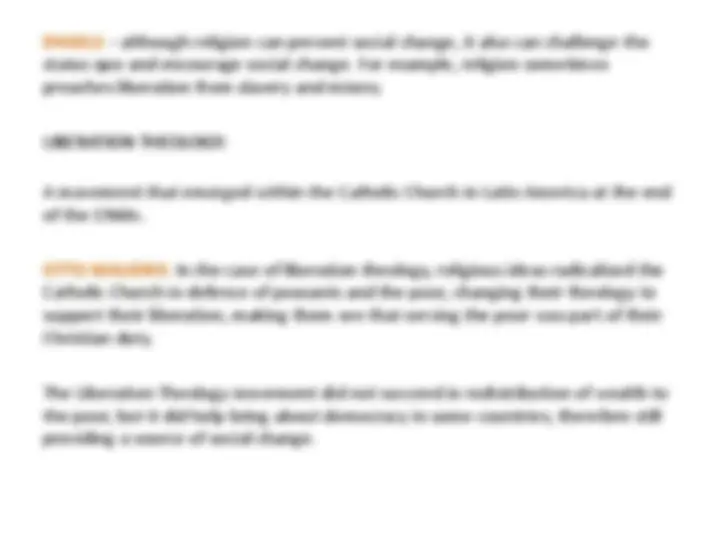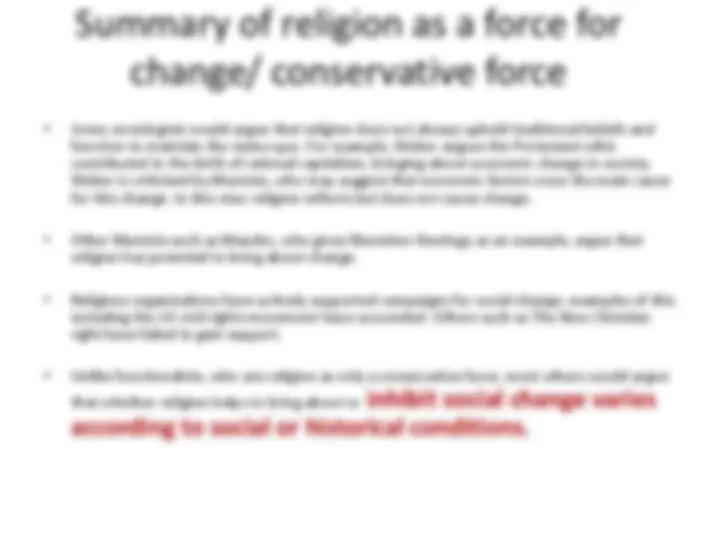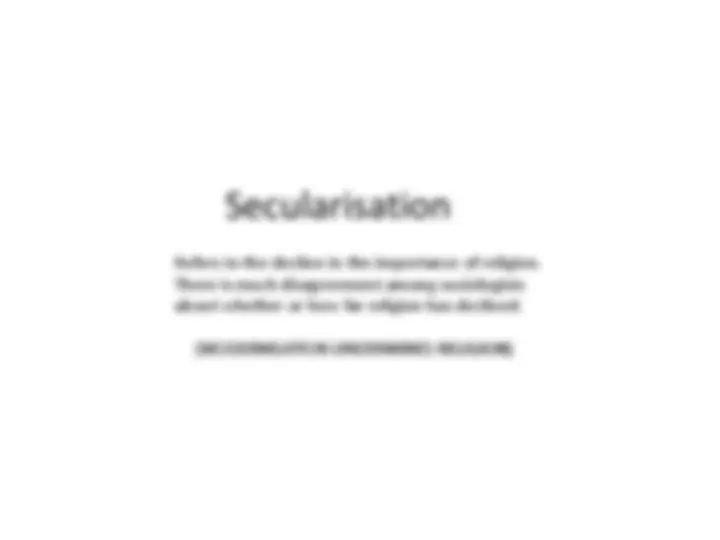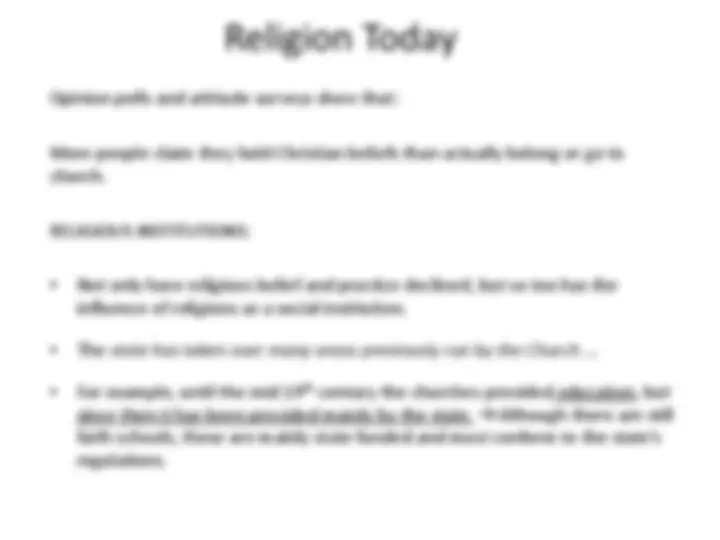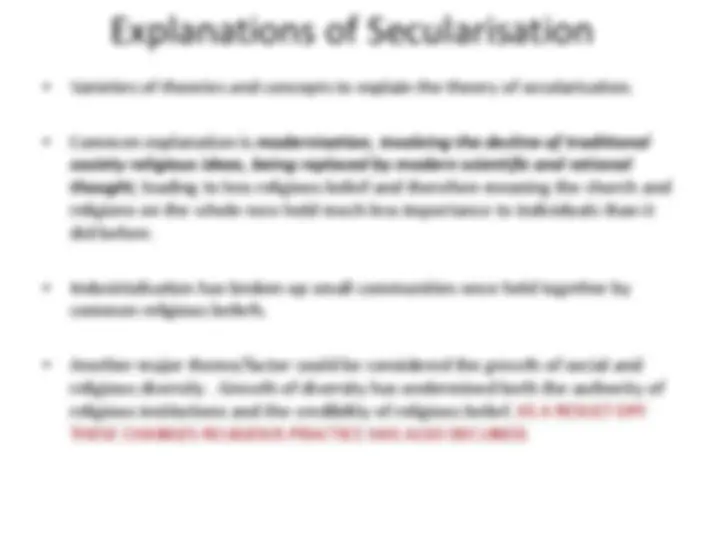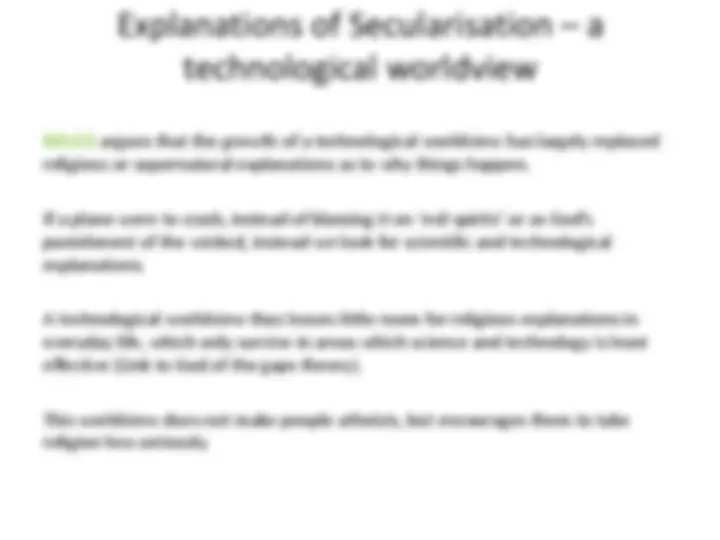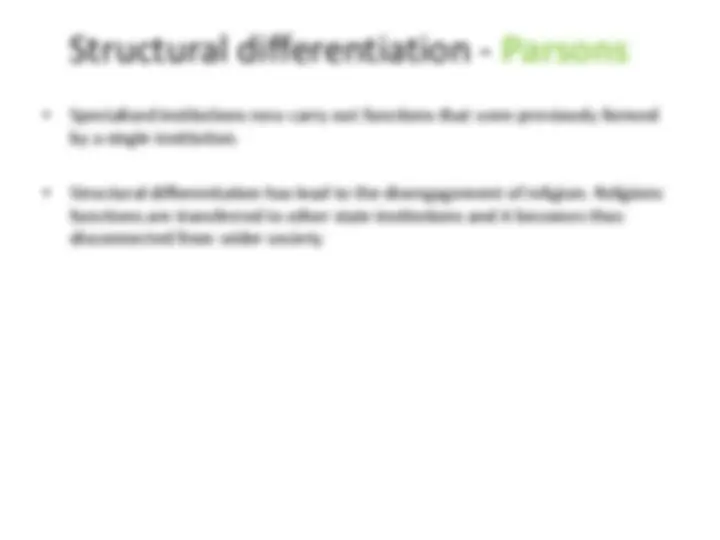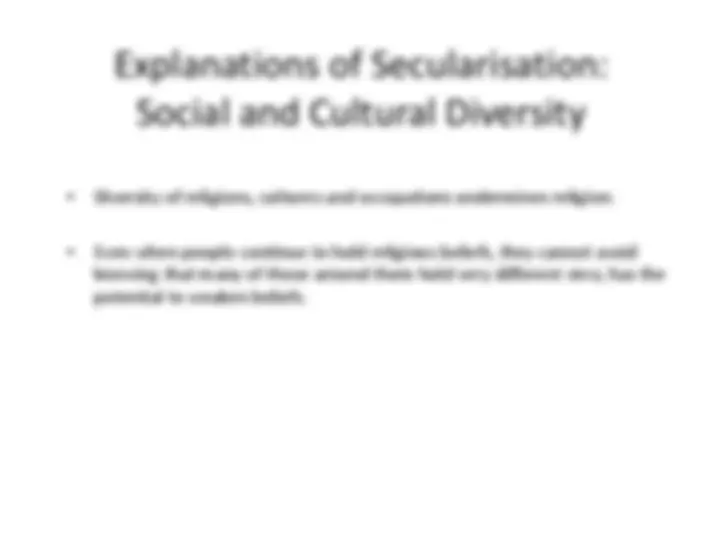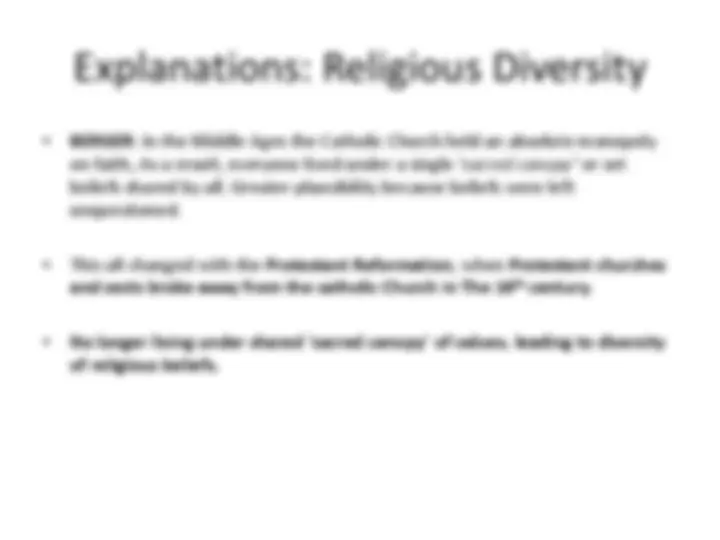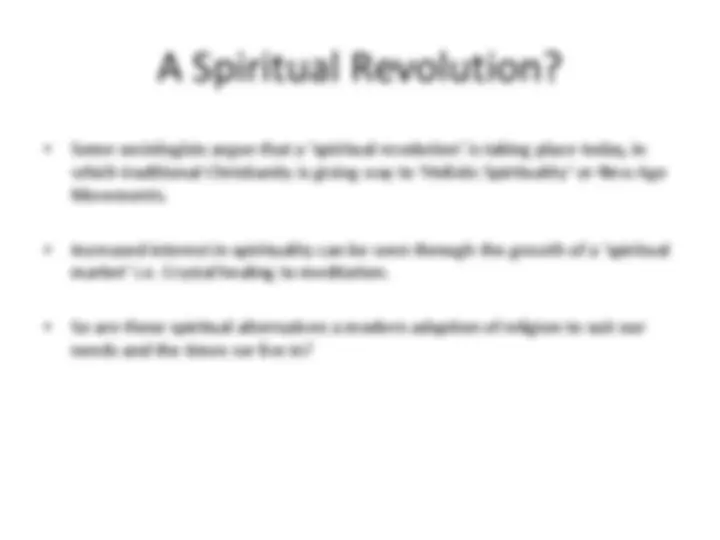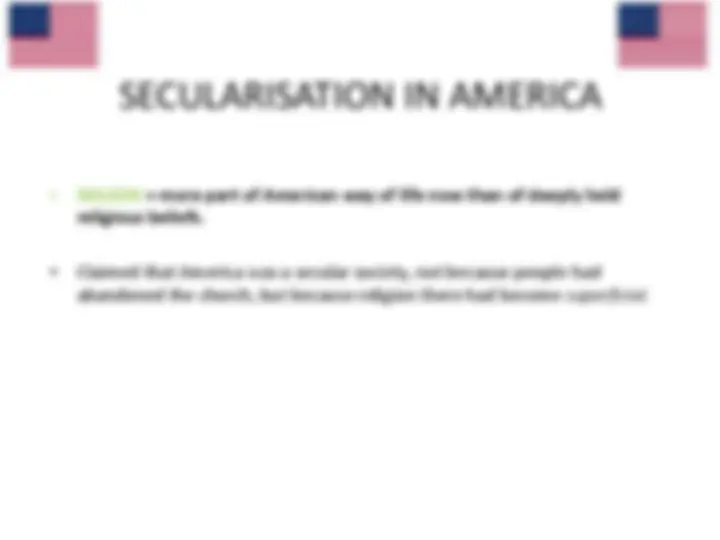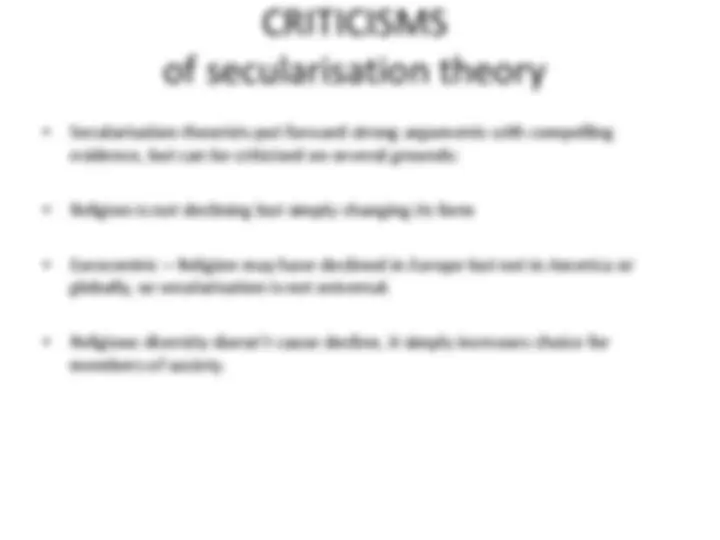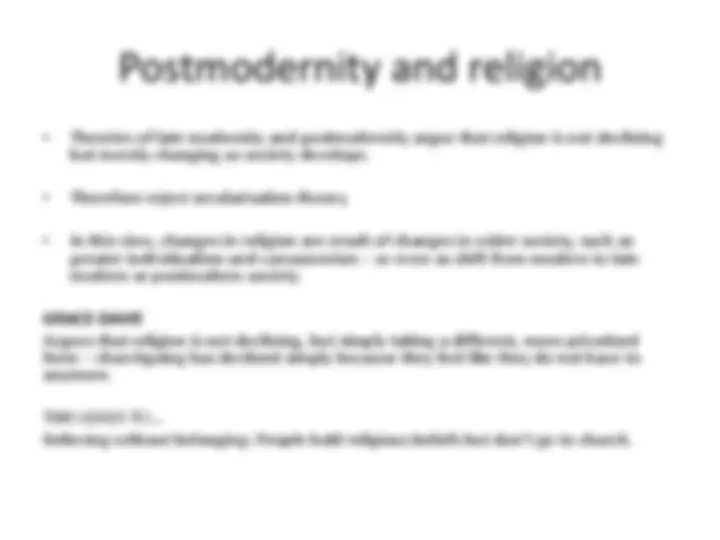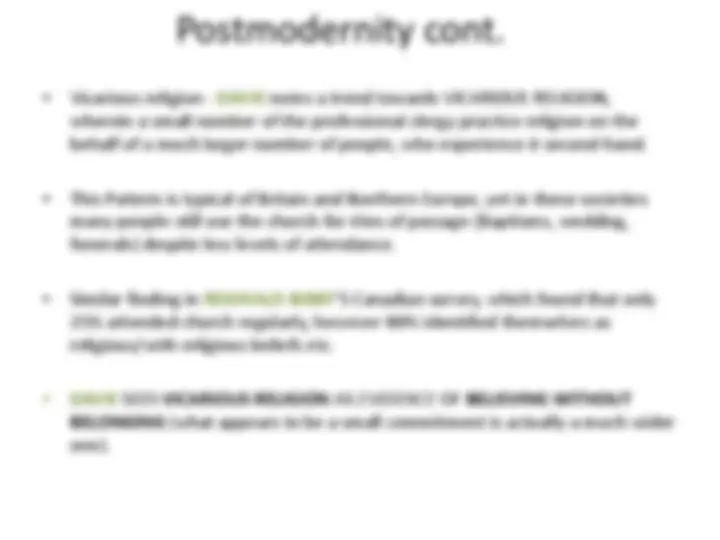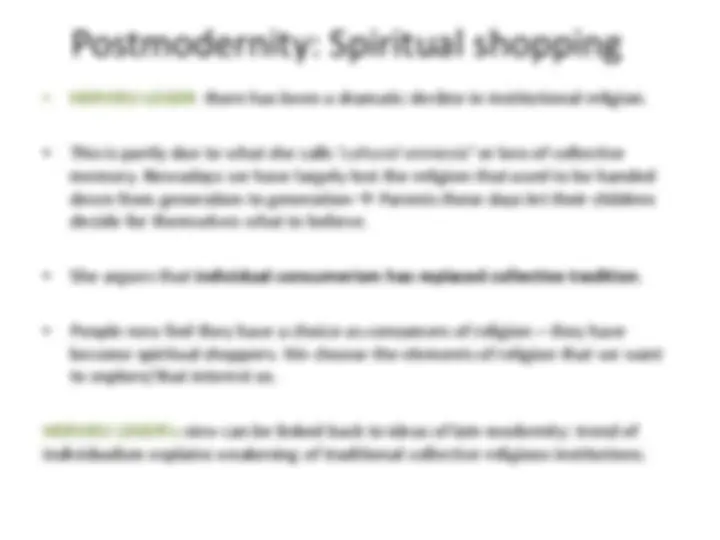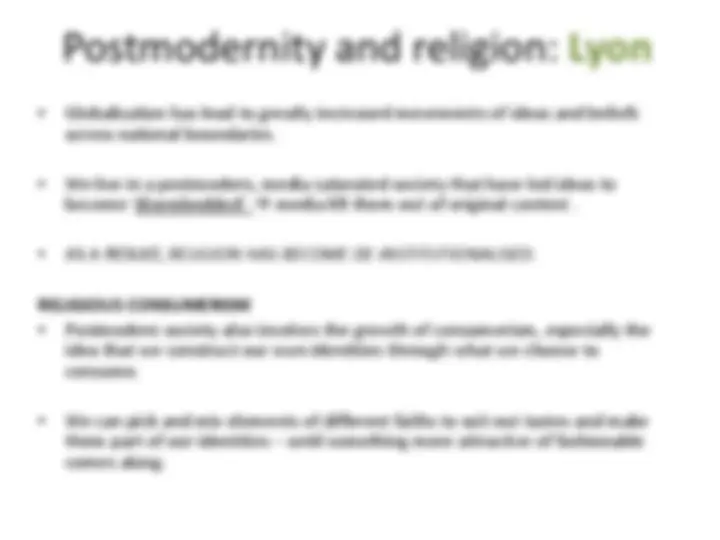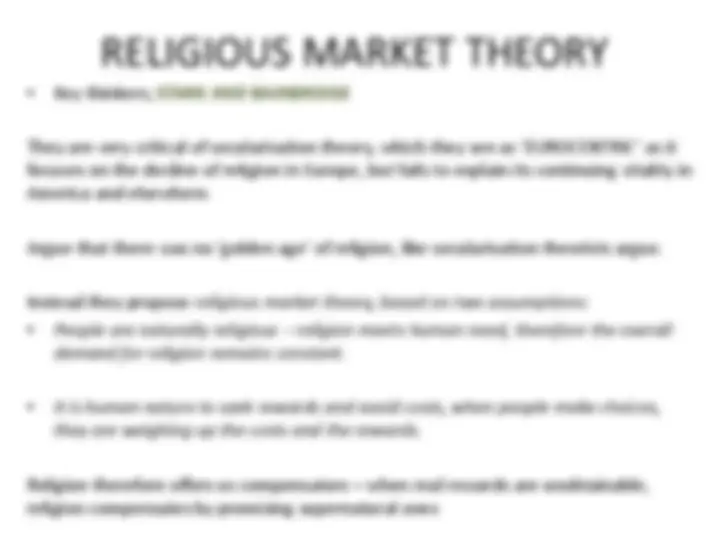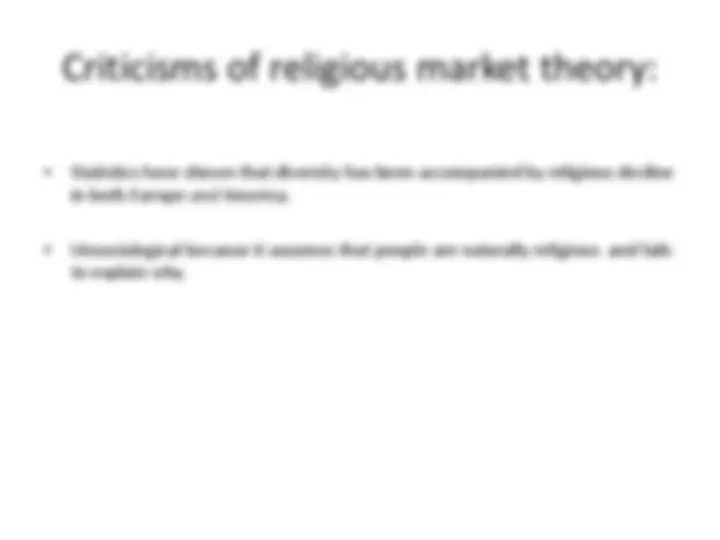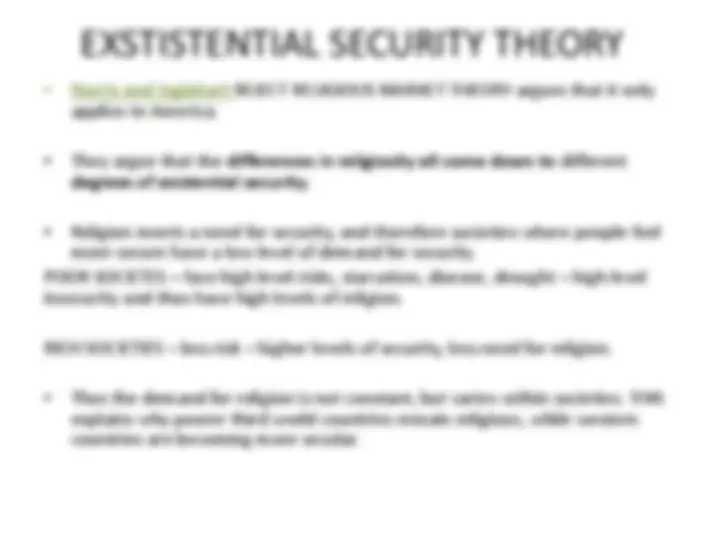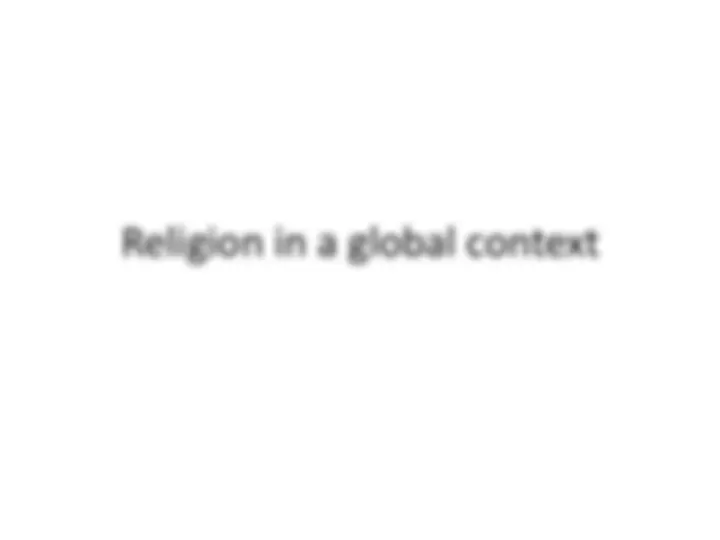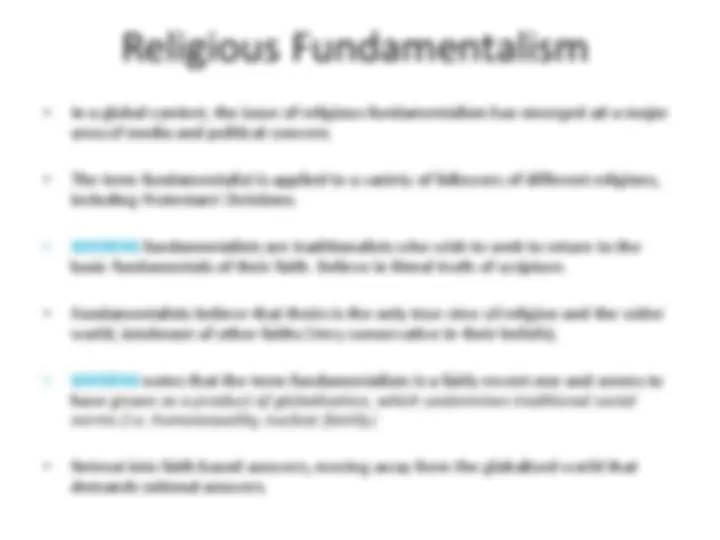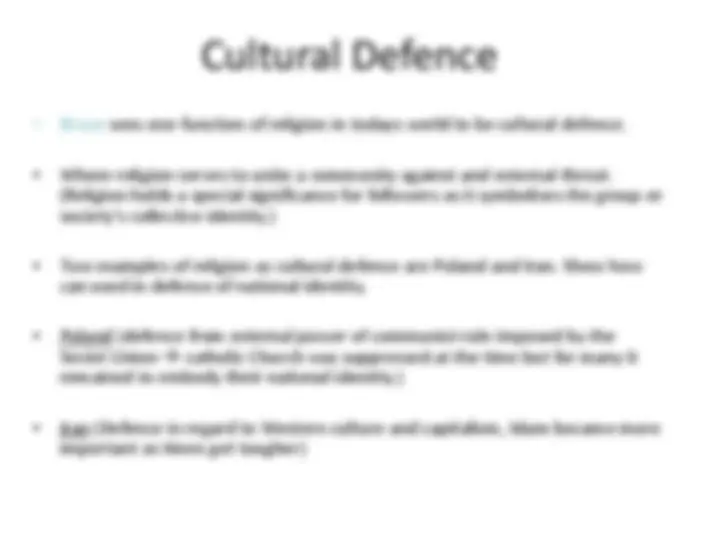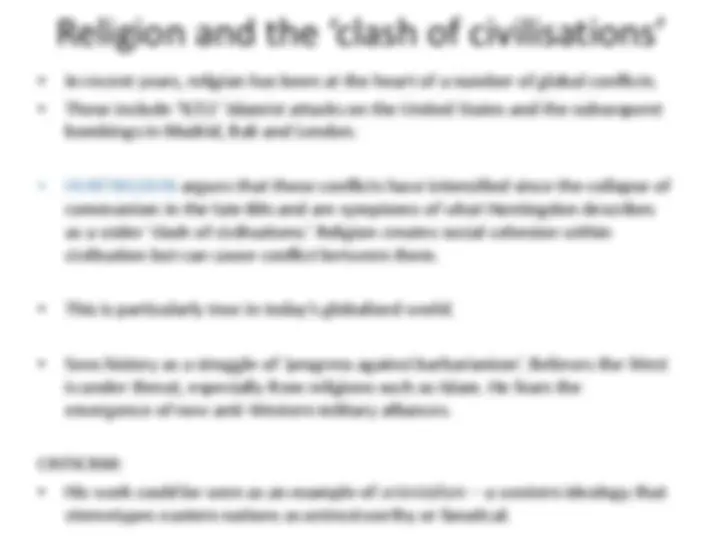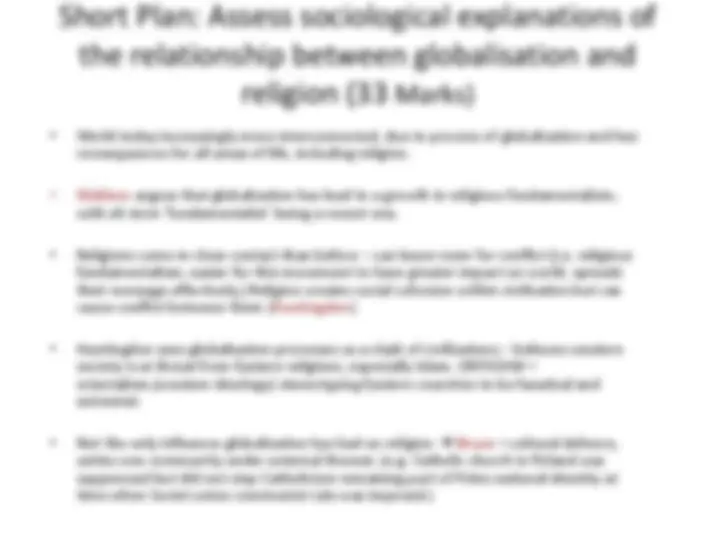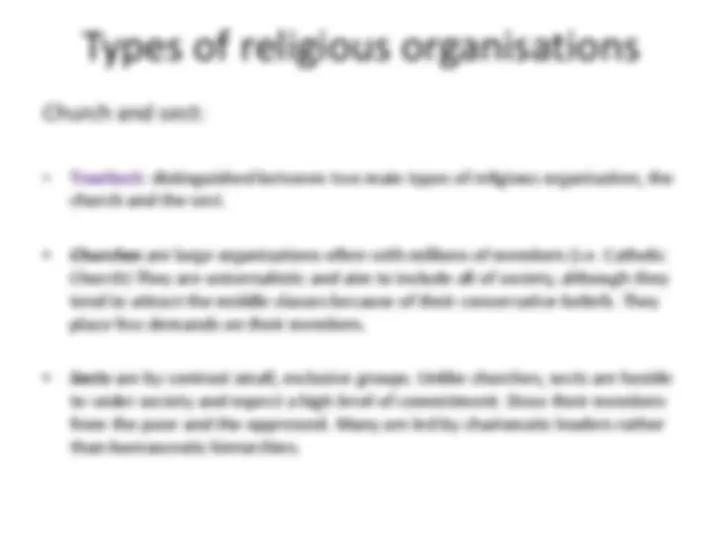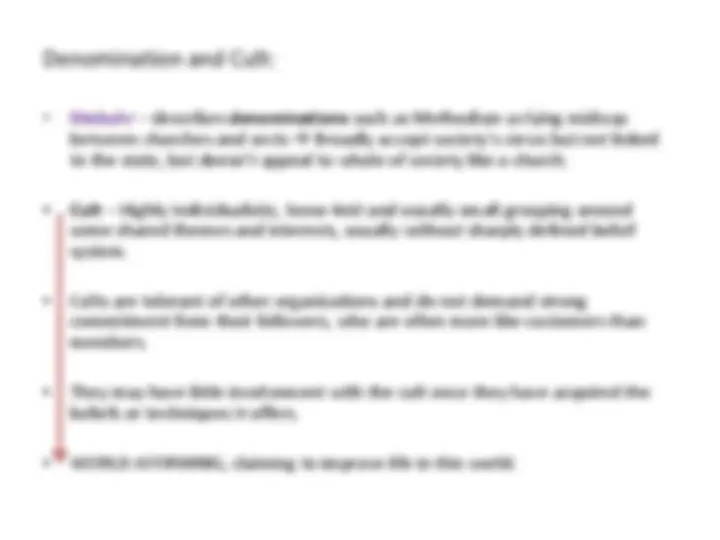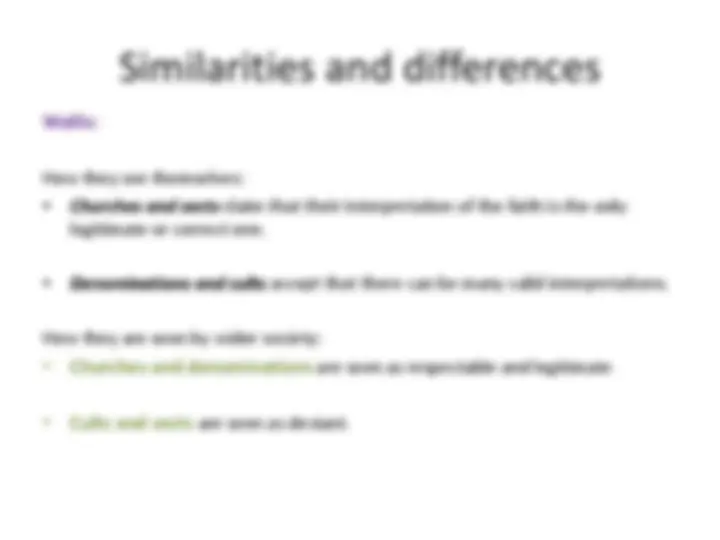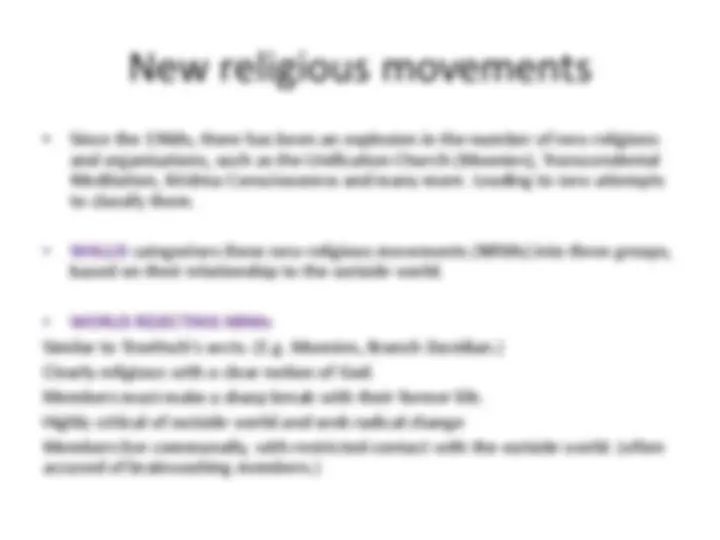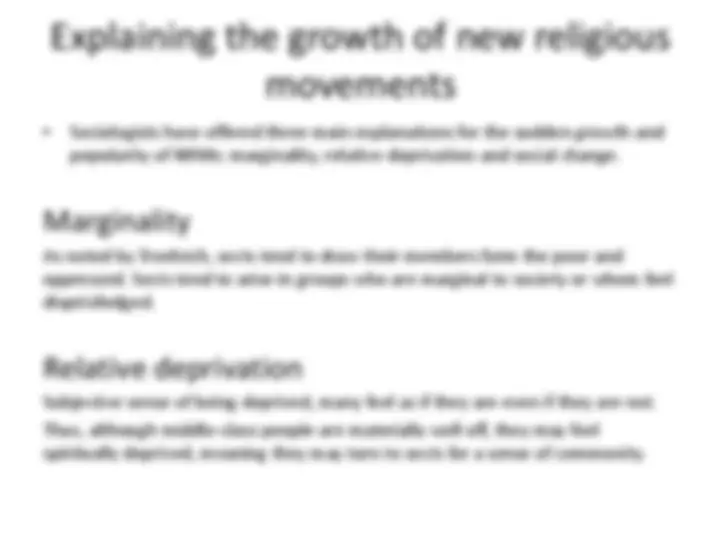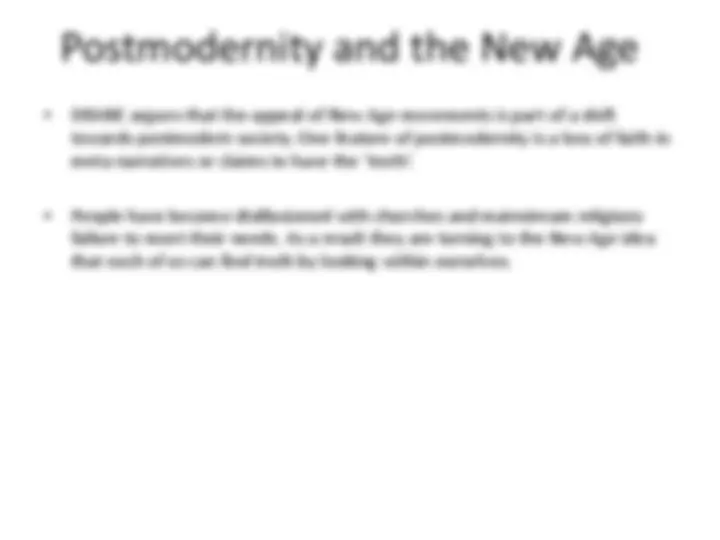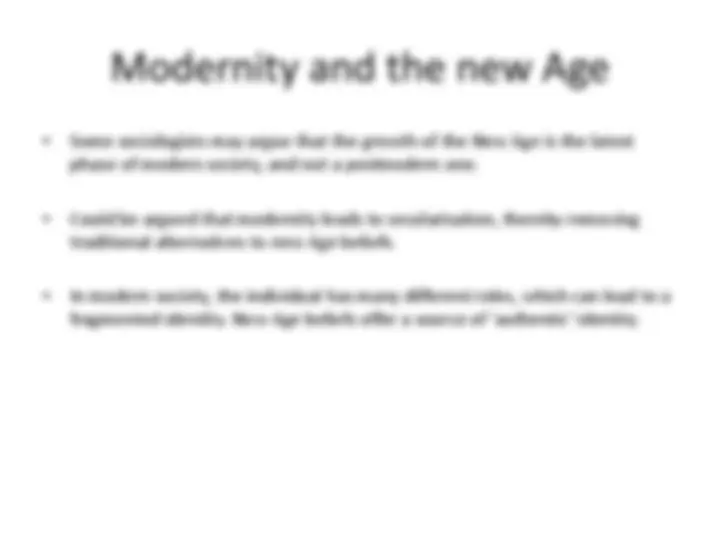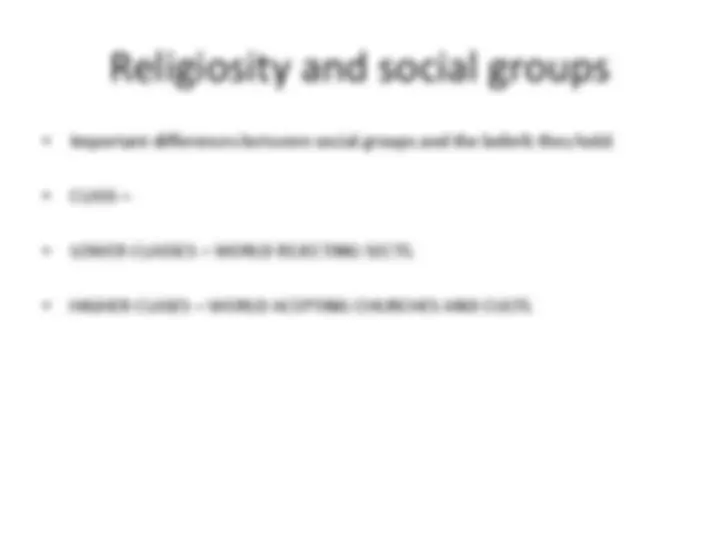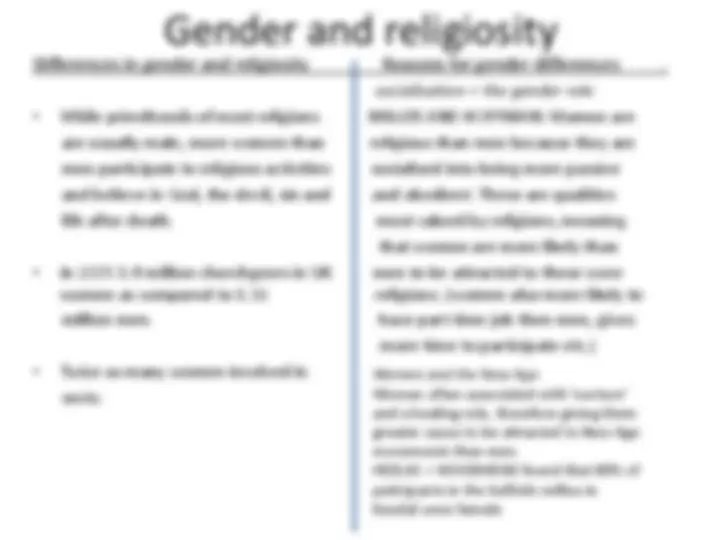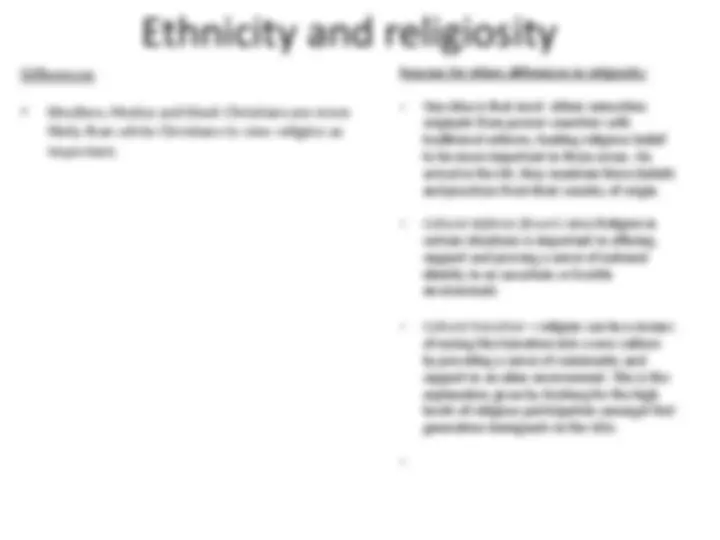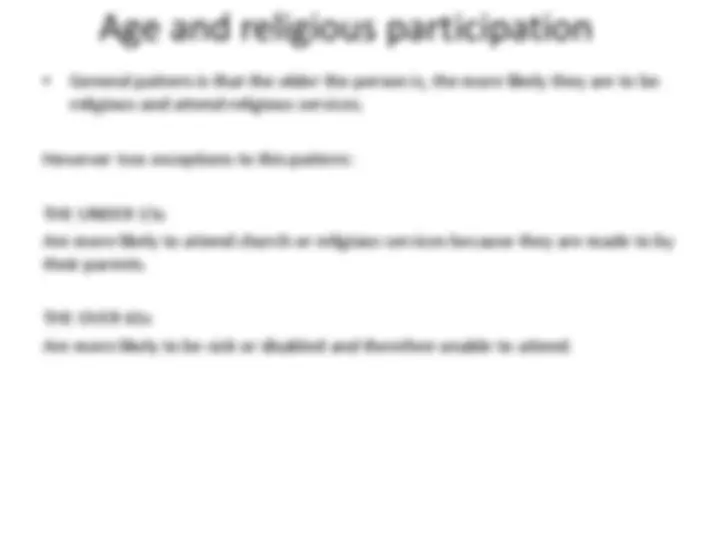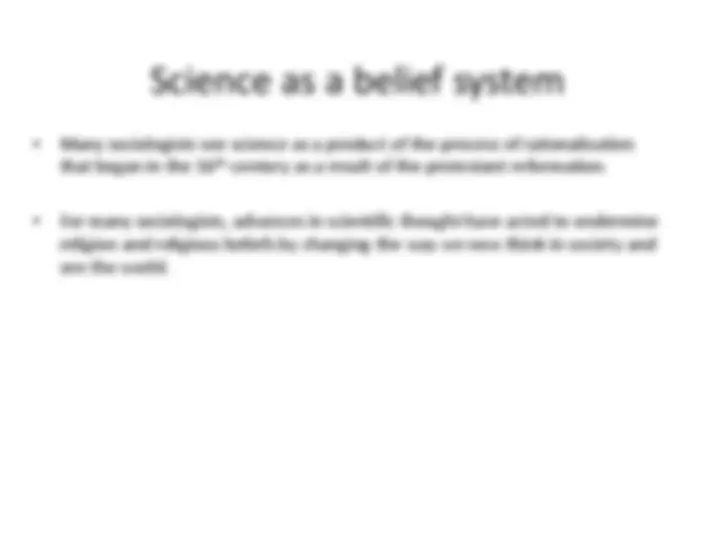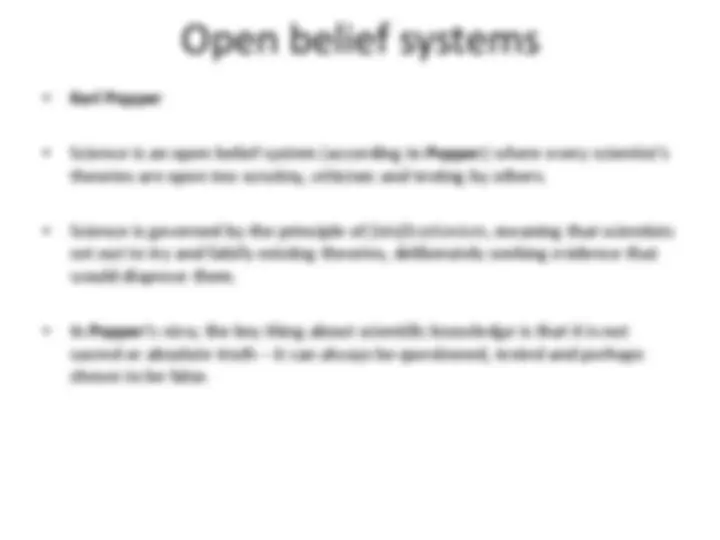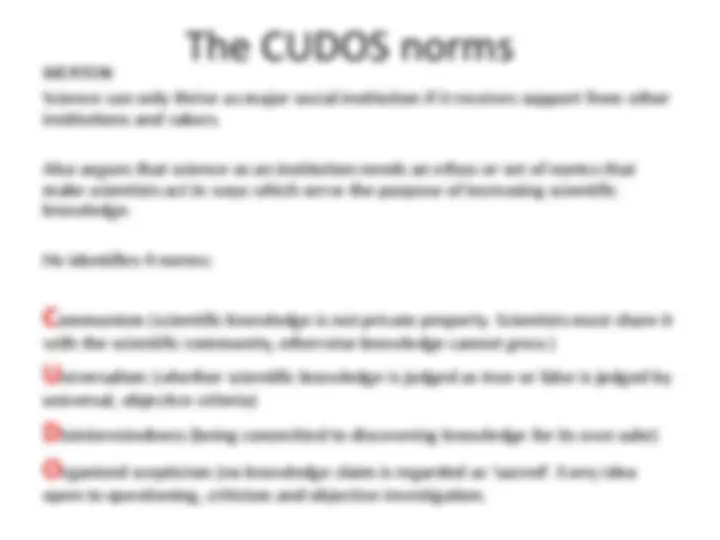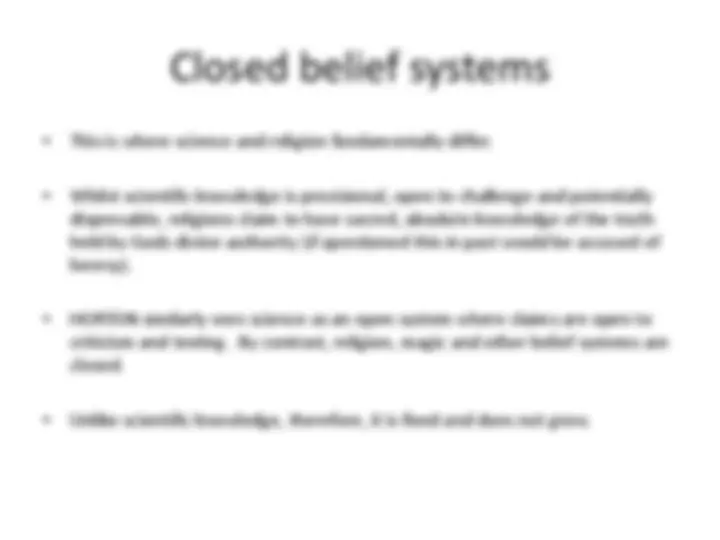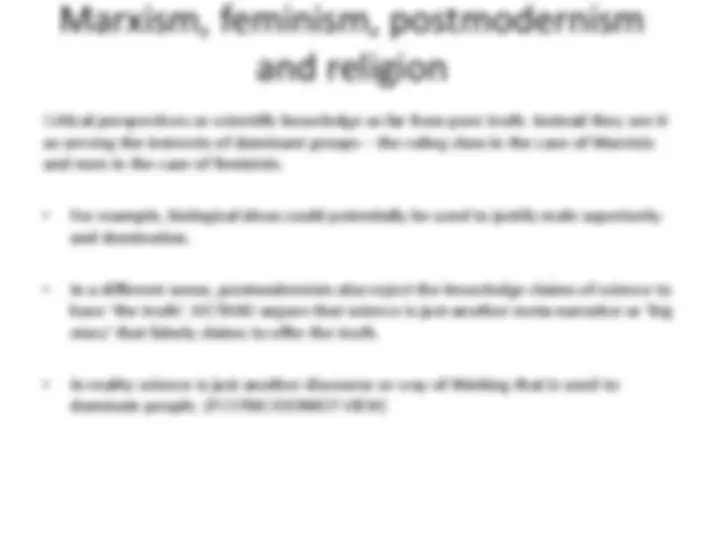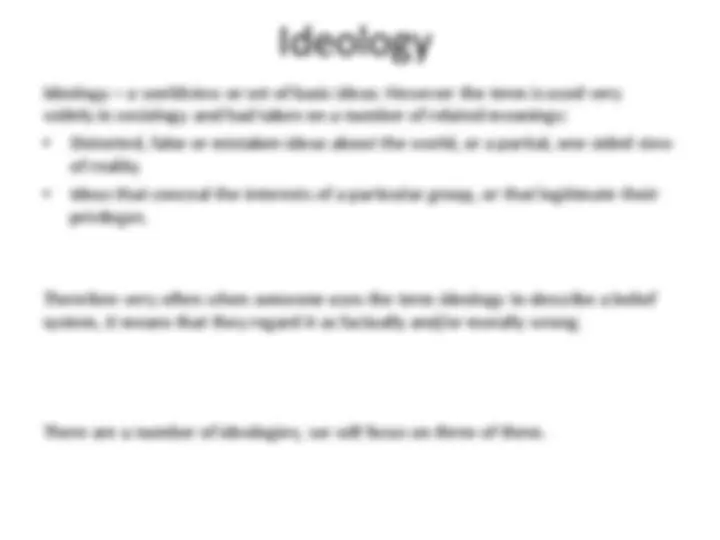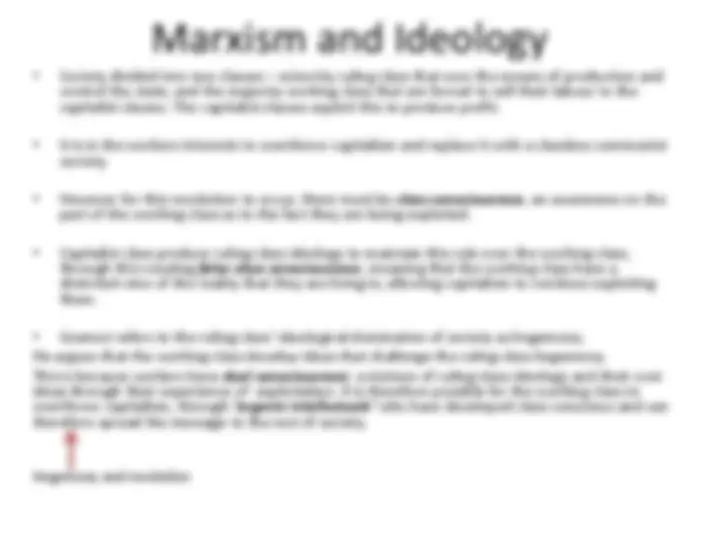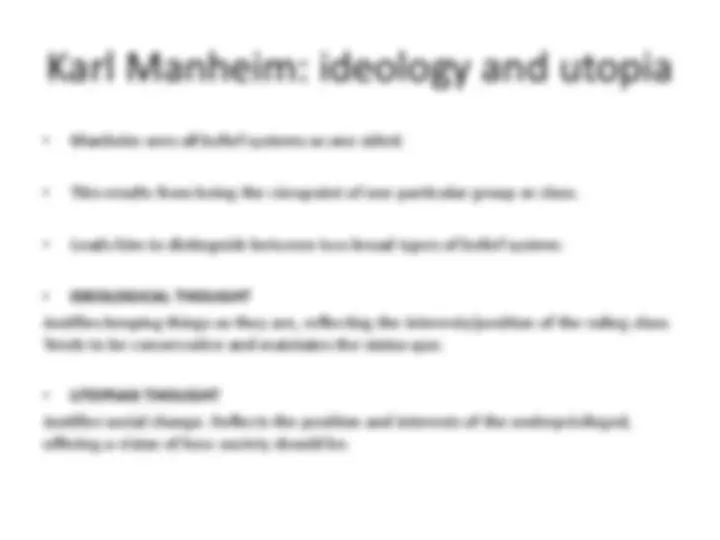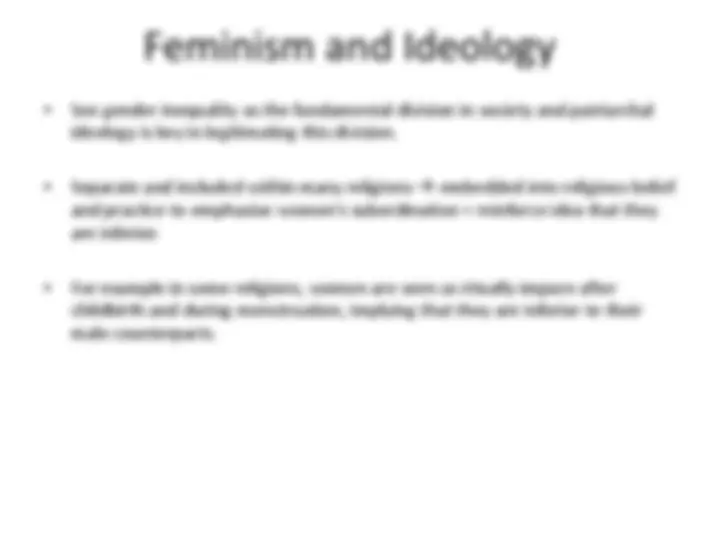Download Functionalist Perspective on Religion: Conservative Force or Catalyst for Change? and more Lecture notes Religion in PDF only on Docsity!
Beliefs in Society
Definitions of Religion
Substantive, Functional and Social constructionist.
- Substantive Focus on the content or substance of religious belief, such as belief in God or the supernatural. Exclusive as they draw a clear line between religious and non-religious belief.
- Functional Define religion through the social or psychological functions it performs. Inclusive as allow us to include a range of beliefs and practices that perform functions.
- Social constructionist Interpretivist approach that focuses on how individual members of society themselves define/construct religion and religious belief. Not possible to produce a single universal definition because different people mean different things by ‘religion’. Do not assume religion always needs belief in God or the supernatural.
Functionalism and Religion
(General)
- Society is a system of interrelated parts. Different institutions (the media, religion, education system) perform certain functions in society to help maintain value consensus and social solidarity needed within all societies.
- For Functionalists, religion plays a big part in creating and maintaining value consensus, order and solidarity.
Functionalism and Religion – The Sacred and The Profane.
- The sacred and the profane (THINKER: DURKHEIM) Key feature of religion was not a belief in God or the supernatural, instead it was the distinction made between the sacred and profane found within society. Sacred – things set apart, special, inspire feelings of awe and wonder. Profane – things that have no special significance, ordinary or mundane. The fact that sacred things evoke such powerful feelings in believers suggests to Durkheim that this is because they represent something of great power. This, in Durkheim's opinion, could only be society itself. So, when members of society are worshipping sacred symbols, they are merely worshipping society and all that it stands for, thus uniting society's members into a single, moral community. Totemism Gave the example of Australian Arunta Aboriginal clan system, and how the totems they worshipped represented the tribe, its origins and identity. Meaning that they worshipping society, even if they were unaware of the fact.
Criticisms of Durkheim
- No sharp division between the sacred and the profane, all of which are culturally relative.
- Durkheim’s theory may apply better to small scale societies with a single religion, very difficult to apply to large scale communities where two or more religions are in conflict with one another, as it does nothing to help promote order, value consensus and social stability.
- Increasing diversity has fragmented the collective conscience , so there is no longer a shared value system for religion to reinforce.
Functionalism – Psychological Functions of Religion Thinker: Broinslaw Malinowski Agrees with Durkheim that religion promotes social solidarity, but in his view this solidarity is achieved by performing psychological functions for individuals - by helping them cope with the emotions and stress that would otherwise undermine social solidarity.
- When the outcome is unpredictable or uncertain. (Troibrand islanders – Fishing in lagoon = safe, so no need for ritual.
- Fishing in the ocean = dangerous, need for ‘canoe magic’.
- At times of life crises. Birth, marriage and especially death mark major and disruptive changes in social groups, and religion helps minimise disruption. For example, funeral rituals reinforce a feeling of solidarity among the survivors, while notion of immortality gives comfort to the bereaved. (He argues death was the main reason for religious belief.)
Functionalism – Civil Religion
THINKER : BELLAH
- What unifies American society is an overarching civil religion – a belief system that attaches sacred qualities to society itself.
- While no individual church or denomination can claim the loyalty of all Americans, civil religion can , as it is the American way of life.
- It is expressed in various symbols and rituals, such as the American flag and singing the national anthem.
Evaluation of Functionalist Theories of
Religion
- Emphasises the positive functions religion performs, but it neglects the negative aspects, such as religion as a source of oppression of women and the poor.
- Ignores religion as a source of division and conflict, where there is religious pluralism (i.e. Northern Ireland), making it hard to see how it can unite people.
- Civil religion overcomes this to some extent by suggesting societies all share overarching belief systems, but can this really be classed as religion? (No belief in God or the supernatural.)
Marxism and Religion
- Marxism sees religion as a feature of only a class divided society, as it is
used by the bourgeoisie or ruling class to legitimate and exploit the
suffering of the proletariat.
- There will be no need for religion in a classless society, meaning it will
disappear.
Religion as an Ideological Weapon
Thinker: Marx Religion is an ideological weapon used by the ruling class to legitimate the suffering of the poor as something inevitable and God-given. Religion misleads the poor into believing that their suffering is virtuous. For example, in Christianity, the Bible states ‘it is easier for a camel to pass through the eye of a needle than a rich man to enter the kingdom of heaven’. Such ideas create false class consciousness – a distorted view of reality that prevents the poor form truly seeing and therefore not being able to change their situation.
Evaluation of Marxism and Religion
- Marx ignores the positive functions religion can have, such as the psychological benefits it may bring to believers etc.
- In many cases it could be argued that religion usually originates from oppressed or poorer groups from which capitalism then takes these ideas to reinforce their own ideas to the masses.
- Religion does not necessarily function effectively as an ideology to control the population.
Feminism and Religion
- Armstrong argues that early religions placed women at the centre. For example earth mother goddesses. Only about 4000 years ago the rise of monotheistic religions saw the establishment of a single, ale omnipotent God.
- Some may argue that in Islam, the Hijab worn by women is evidence of their oppression under Islam. Many others, including Woodhead suggest that is in fact liberating for women, giving them access to the public sphere of society without having to tolerate the patriarchal male gaze.
- Bevoir – Women are sometimes portrayed in religion as being closer to God, but only if they are passive and obedient.
- Holm – Bible written exclusively by men, God, Jesus and Prophets all men. Even made From Adams rib. Even in Sikhism, the most equal of religions, most important roles within the religion filled by men. CRITICISM of feminist theories of religion: It should be noted that the position of women within some religions is chancing. For example, the Church of England has permitted women to become priests since 1992, and now about a fifth of all its priests are female.
Religion and Social Change

